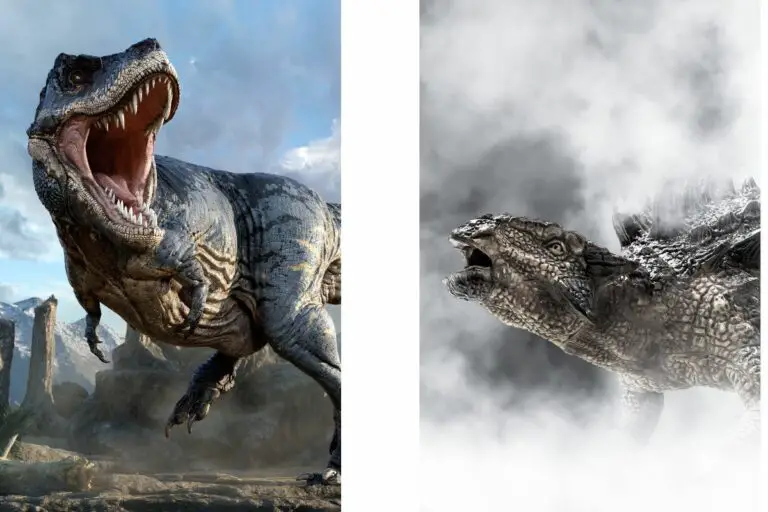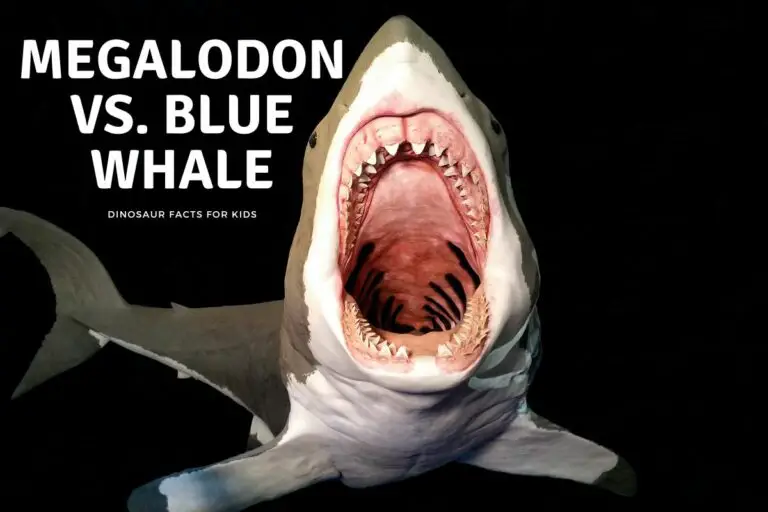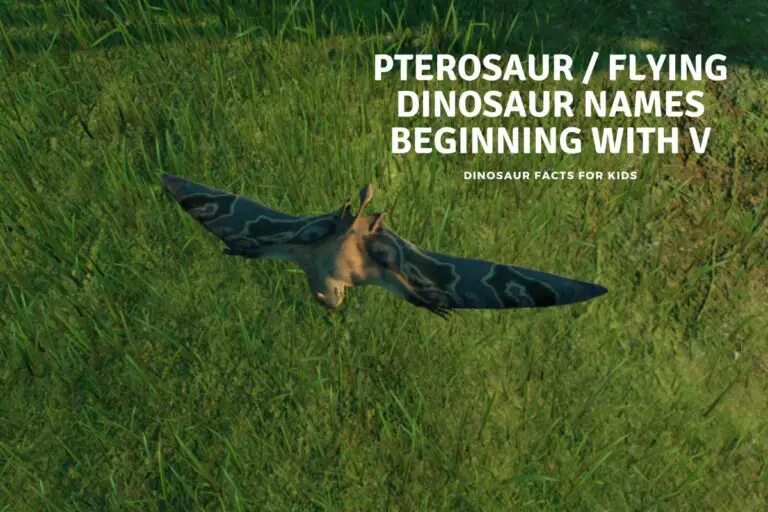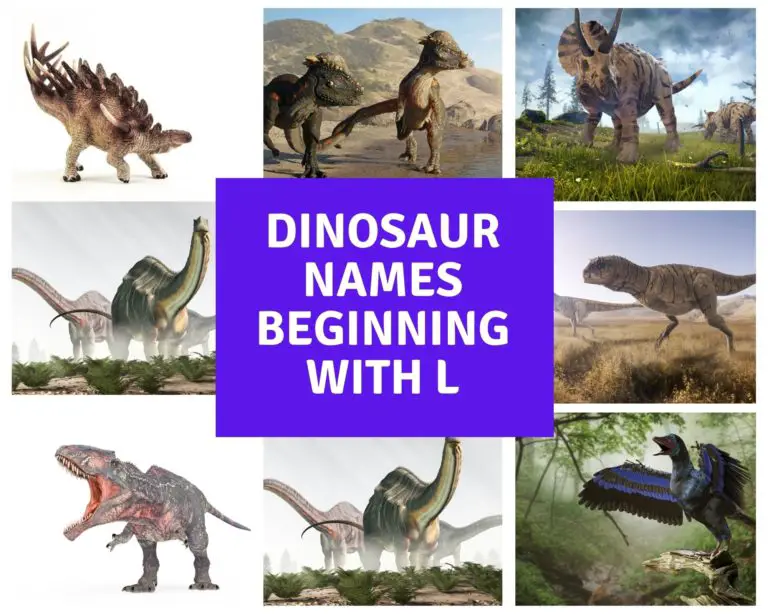List of Flying Dinosaur Names: All Pterosaur Species!
Welcome to a captivating journey through time as we embark on an alphabetical exploration of the incredible world of flying dinosaurs. From the towering giants like Quetzalcoatlus to the swift and agile hunters like Angustinaripterus, Flying dinosaurs are also, and more scientifically, known as Pterosaurs. They lived along side regular dinosaurs and are often mistaken for them.
However they were different in many ways and are classed as flying reptiles, and this Flying dinosaur name list will highlight these and give you an idea and some information on all 250 + species of flying dinosaurs / pterosaurs discovered so far!
This A to Z list of flying dinosaurs names will introduce you to all of the Pterosaurs that have been uncovered, and with more discovered each year be sure to check back to see what new flying dinosaur names have been added!
Click to Jump to the Flying Dinosaur Page Of your Choice!
A B C D E F G H I J K L M N O P Q R S T U V W X Y Z
Pterosaurs Beginning with A

Steven U. Vidovic, David M. Martill, CC BY 2.5 https://creativecommons.org/licenses/by/2.5, via Wikimedia Commons
Name: Aerodactylus
When Lived: Late Jurassic
Wingspan: 1.5 ft wingspan
Discovered: 1850
Where: Germany
Diet: carnivore
Aerodactylus
Name meaning: Wind Finger
Aerodactylus is a small extinct species of pterosaur that lived during the Late Jurassic period, around 150 million years ago. It was discovered in Germany.
Aerodactylus was a small pterosaur, with an estimated wingspan of about 50 cm (or half a meter), roughly the size of a modern-day seagull.
This flying reptile likely ate small prey, possibly including insects and small vertebrates.
One of the unique features of Aerodactylus is its long, pointed teeth that jutted out, even when its mouth was closed, giving it a somewhat fearsome appearance.
More Information
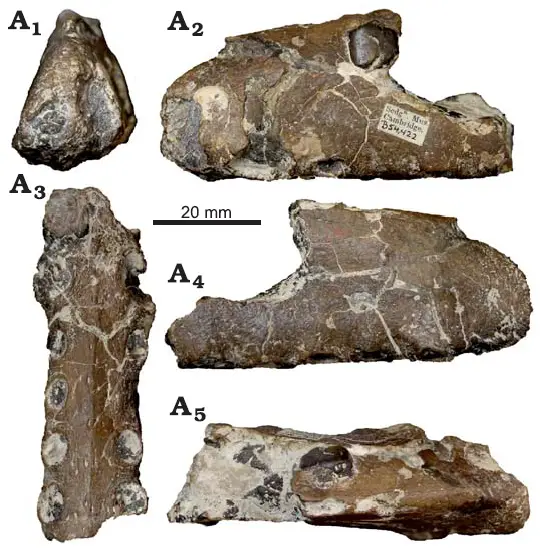
Borja Holgado and Rodrigo V. Pêgas, CC BY 4.0 https://creativecommons.org/licenses/by/4.0, via Wikimedia Commons
Name: Aerodraco
When Lived: Late Cretaceous
Wingspan: 6.5 ft wingspan
Discovered: 1859
Where: UK
Diet: carnivore
Aerodraco
Name meaning: Air Dragon
Aerodraco, also known as “air dragon,” is a type of pterosaur that lived during the Late Cretaceous period. This creature was discovered in the UK, specifically in the chalk beds of the Isle of Wight.
Based on the available fossils, scientists estimate that its wingspan was about 2 meters (approximately 6.5 feet), making it a relatively medium-sized pterosaur.
It’s believed that Aerodraco, like many pterosaurs, was carnivorous, feeding on fish and other small animals. Its most striking features were its long, sharp teeth and elongated snout, which would have been useful for catching prey.
More Information
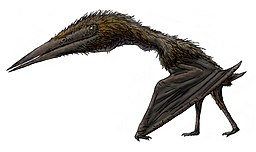
FunkMonk (Michael B. H.), CC BY-SA 3.0 https://creativecommons.org/licenses/by-sa/3.0, via Wikimedia Commons
Name: Aerotitan
When Lived: Late Cretaceous
Wingspan: 33 ft wingspan
Discovered: 2012
Where: South America
Diet: Carnivore
Aerotitan
Name meaning: Air Giant
Aerotitan is a type of azhdarchid pterosaur discovered in Argentina, from the Late Cretaceous period.
While there is limited information due to the scarcity of fossils, it’s generally believed that Aerotitan was quite large – like other azhdarchids, it could have had a wingspan of over 10 meters (or 33 feet). Its diet likely consisted of small animals and possibly carrion.
Its long neck and similarly elongated, toothless beak would have been beneficial for reaching down and picking up food.
Azhdarchids like Aerotitan also had long, stilt-like legs, suggesting that they were adapted for a terrestrial lifestyle, perhaps stalking the prehistoric plains in search of a meal.
More Information
Name: Aetodactylus
When Lived: Late Cretaceous
Wingspan: 10 ft wingspan
Discovered: 2010
Where: Texas, U.S.A
Diet: Carnivore
Aetodactylus
Name meaning: Eagle finger
Aetodactylus is a genus of ornithocheirid pterosaur that lived during the Late Cretaceous period. Its fossils were found in Texas, USA.
The name “Aetodactylus” means “eagle finger,” indicating its prowess in the sky. This medium-sized pterosaur had a wingspan of about 3 meters (about 10 feet).
Its teeth were sharp and pointed outward, perfect for catching its likely diet of fish.
Interestingly, Aetodactylus is one of the few pterosaurs discovered in North America belonging to the ornithocheirid family, which is primarily known from Brazil and England.
More Information
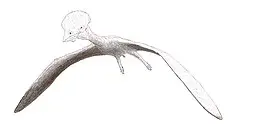
Antonio R. Mihaila, CC BY-SA 4.0 https://creativecommons.org/licenses/by-sa/4.0, via Wikimedia Commons
Name: Afrotapejara
When Lived: Early Cretaceous
Wingspan: Unsure
Discovered: 2020
Where: Morocco, Africa
Diet: Fruit
Afrotapejara
Name meaning: African Old being
Afrotapejara is a genus of tapejarid pterosaur, discovered in the Kem Kem Beds of Morocco, Africa. It lived during the Early Cretaceous period.
The name “Afrotapejara” signifies its African origin and its similarity to the tapejarid family. Like other tapejarids,
Afrotapejara likely had a distinctive crest on its head. It is thought to have been a fruit eater, using its beak to pluck fruits from trees.
Its wingspan is currently unknown due to the fragmentary nature of its fossils, but similar species had wingspans around 4 meters (around 13 feet).
More Information
Name: Alamodactylus
When Lived: Late Cretaceous
Wingspan: Unsure
Discovered: 2010/13
Where: Texas. USA
Diet: Carnivore
Alamodactylus
Name meaning: Alamo finger
Alamodactylus is a pterosaur that lived during the Late Cretaceous period. The fossils of Alamodactylus were discovered in Texas, USA.
Its name “Alamodactylus” references the Alamo, a historic site in Texas, and “dactylus,” meaning “finger” in Greek, a common suffix for pterosaurs.
Alamodactylus belonged to the family Pteranodontidae, known for their keel-shaped crests and toothless beaks.
While we don’t have an exact size, similar pterosaurs had wingspans of around 4-5 meters (13-16 feet). They likely ate fish, swooping over the water to catch their prey.
More Information

Nizar Ibrahim, David M. Unwin, David M. Martill, Lahssen Baidder, Samir Zouhri, CC BY 2.5 https://creativecommons.org/licenses/by/2.5, via Wikimedia Commons
Name: Alanqa
When Lived: Late Cretaceous
Wingspan: 13-20ft
Discovered: 2010
Where: Morocco, Africa
Diet: Carnivore
Alanqa
Name meaning: Phoenix
Alanqa is a type of pterosaur that lived during the Late Cretaceous period, its fossils found in the Kem Kem Beds of Morocco.
The name “Alanqa” comes from the Arabic word for “phoenix.” Alanqa was large for a pterosaur, with an estimated wingspan of up to 6 meters (around 20 feet).
Its most remarkable feature was its long, spear-like jaw, which suggests it may have had a diet of fish and small animals.
Alanqa’s jaw also lacked teeth, unlike many other pterosaurs. It probably used its jaw like a pair of tweezers, to snap up prey from the water or ground.
More Information
Name: Albadraco
When Lived: Late Cretaceous
Wingspan: 16-20ft
Discovered: 2012/19
Where: Spain
Diet: Carnivore
Albadraco
Name meaning: Alba Dragon
Albadraco is a type of pterosaur that lived during the Late Cretaceous period. Its fossils were discovered in the La Huérguina Formation of Spain.
Its name “Albadraco” combines “Alba” (from Albacete, the province where its remains were found) and “draco” (Latin for dragon).
The exact size of Albadraco is not well-known, as the fossil record is limited, but estimates have the wingspans of around 5-6 meters (about 16-20 feet).
Albadraco was a member of the Ornithocheiridae family, which is typically characterized by a bony crest and long, Though more rounded in albadraco, slender jaws.
More Information
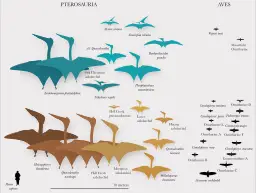
Nicholas R. Longrich , David M. Martill, Brian Andres, CC BY 4.0 https://creativecommons.org/licenses/by/4.0, via Wikimedia Commons
Name: Alcione
When Lived: Late Cretaceous
Wingspan: 5-8ft
Discovered: 2018
Where: Morocco
Diet: Piscivore / Carnivore
Alcione elainus
Name meaning: Alcyone wandering
Alcione elainus was a pterosaur from the Late Cretaceous period. It was discovered in Morocco.
The name “Alcione” is derived from Alcyone of Greek mythology, who was turned into a seabird. It had a relatively modest wingspan of about 2 – 2.5 meters (5-8 feet).
It was a member of the Pteranodontia group, a classification of pterosaurs that generally had toothless beaks.
This suggests that Alcione elainus was likely a fish eater, using its beak to snatch fish from the surface of the water.
More Information

Laura Codorniú1, Ariana Paulina Carabajal2, Diego Pol3, David Unwin4, Oliver W.M. Rauhut5, CC BY 4.0 https://creativecommons.org/licenses/by/4.0, via Wikimedia Commons
Name: Allkaruen
Lived: Early / Mid Jurassic
Wingspan: 3-4ft
Discovered: 2016
Where: Argentina
Diet: Carnivore
Allkaruen
Name meaning: Ancient Brain
Allkaruen is a pterosaur that lived during the Early to Middle Jurassic period. Its fossils were found in Argentina. “Allkaruen” means “ancient being” in the Tehuelche language.
It is considered significant due to its age – it’s one of the few pterosaurs known from the Early / Middle Jurassic.
The exact size of Allkaruen is unclear due to incomplete fossils, but it is thought to be small as similar pterosaurs had wingspans of about 1 meter (3.3 feet).
Given its early existence in the evolution of pterosaurs, it likely had a diet of insects and small animals.
More Information
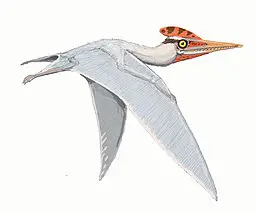
Dmitry Bogdanov, CC BY-SA 3.0, via Wikimedia Commons
Name: Altmuehlopterus
Lived: Late Jurassic
Wingspan: 3-4ft
Discovered: 1851/2017
Where: Germany
Diet: Piscivore / Carnivore
Altmuehlopterus
Name meaning: Altmühl River wing
Altmuehlopterus was a pterosaur that lived during the Late Jurassic period. Its fossils were discovered in the Solnhofen limestone region of Germany, from which it derives its name.
The exact size of Altmuehlopterus is estimated to be around 1-1,2 metres so a 3-4 feet wingspan.
Its diet likely consisted of fish and small invertebrates, captured by swooping over the water and the beaches and grabbing prey with its beak and teeth.
More Information
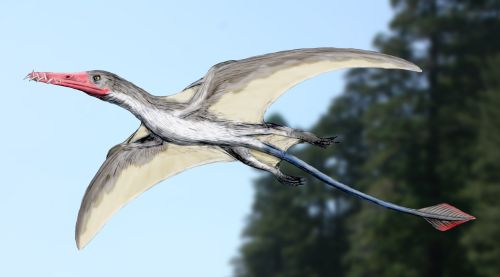
Nobu Tamura (http://spinops.blogspot.com), CC BY 3.0 via Wikimedia Commons
Name: Angustinaripterus
Lived: Mid Jurassic
Wingspan: 5 ft
Discovered: 1983
Where: China
Diet: Carnivore/piscivore
Angustinaripterus
Name meaning: narrow nostril Wing
Angustinaripterus is a pterosaur that lived during the Middle Jurassic period. Its fossils were discovered in the Shandong Province of China.
The name “Angustinaripterus” means “narrow nostril wing”. The precise size of Angustinaripterus is uncertain due to the limited fossil record, but similar pterosaurs had wingspans of about 1-1.5 meters (around 3-5 feet).
Angustinaripterus was likely a carnivore, feeding on small animals and possibly fish and had a unique jaw structure with both sharp longer teeth at the front and smaller at the back.
More Information
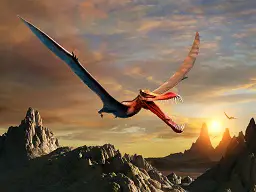
Name: Anhanguera
Lived: Early Cretaceous
Wingspan: 15 ft
Discovered: 1985
Where: Brazil
Diet: Carnivore/piscivore
Anhanguera
Name meaning: Bygone Spirt protector of animals
Anhanguera is a genus of pterosaur that lived during the Early Cretaceous period.
It was discovered in Brazil, with the name “Anhanguera” meaning “old devil” in the Tupi language. Anhanguera had a large wingspan of around 4.5 meters (about 15 feet).
It was known for its long, narrow jaws filled with sharp teeth, and a spoon shape at the end suggesting it was a piscivore, preying on fish from the vast prehistoric seas it soared over.
One of its distinguishing features is a crest on its upper jaw, which may have been used in courtship displays and mating rituals
More Information
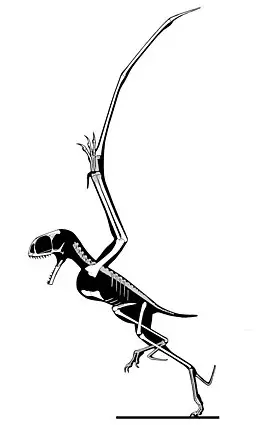
Jaime A. Headden (User:Qilong), CC BY 3.0 https://creativecommons.org/licenses/by/3.0, via Wikimedia Commons
Name: Anurognathus
Lived: Late Jurassic
Wingspan: 15 ft
Discovered: 1922
Where: Germany
Diet: insectivore
Anurognathus
Name meaning: Without Tail Jaw
Anurognathus is a small pterosaur from the Late Jurassic period, found in Germany. The name “Anurognathus” translates to “tail-less jaw”,
A reference to its noticeably short tail compared to other pterosaurs. It had a modest wingspan of about 50 cm (1.6 feet).
Anurognathus is interesting because it was likely an insectivore, its short, broad jaws studded with small, pointed teeth, perfect for snatching insects out of the air.
Its eyes were large and faced forward, suggesting good depth perception for hunting. It looked kind of like a prehistoric bat!
More Information
https://eartharchives.org/articles/anurognathus-the-tiny-jurassic-pterosaur/index.html
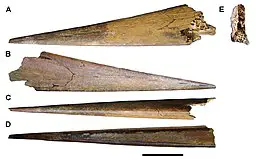
Nizar Ibrahim, Paul C. Sereno, David J. Varricchio, David M. Martill, Didier B. Dutheil, David M. Unwin, Lahssen Baidder, Hans C. E. Larsson, Samir Zouhri, Abdelhadi Kaoukaya, CC BY 4.0 https://creativecommons.org/licenses/by/4.0, via Wikimedia Commons
Name: Apatorhamphus
Lived: Late Cretaceous
Wingspan: 10-23 ft
Discovered: 2016/2022
Where: Morocco
Diet: unknown
Apatorhamphus
Name meaning: Deceptive snout
Apatorhamphus is a pterosaur that lived during the Late Cretaceous period, with its fossils discovered in Morocco.
Exact details about Apatorhamphus are hard to determine due to limited fossils only its beak has been found so far so classifying it is difficult ( hence the name!)
Its wingspan is not certain, but comparable pterosaurs had wingspans of between 3 to 7 metres ( 10-23 feet). Its beak was toothless and pointed.
More Information
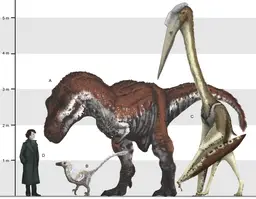
Mark P. Witton, CC BY 2.0 https://creativecommons.org/licenses/by/2.0, via Wikimedia Commons
Name: Arambourgiania
Lived: Late Cretaceous
Wingspan: 26-30 ft
Discovered: 1959/1989
Where: Jordan
Diet: Carnivore
Arambourgiania
Name meaning: for Arambourg
Arambourgiania is a type of pterosaur that lived during the Late Cretaceous period. Its fossils were found in Jordan and its name honors the French paleontologist Camille Arambourg.
This pterosaur is one of the largest known, with a wingspan that may have reached 8-9 meters (around 26-30 feet). Its neck vertebra is nearly 1 meter long (over 3 feet), hinting at a long, slender neck.
Arambourgiania belonged to the Azhdarchidae family, known for their long necks and toothless jaws, suggesting a diet of small animals and possibly carrion.
More Information
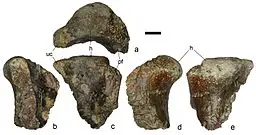
Alexander Averianov, Gareth Dyke, Igor Danilov, Pavel Skutschas, CC BY 3.0 https://creativecommons.org/licenses/by/3.0, via Wikimedia Commons
Name: Aralazhdarcho
Lived: Late Cretaceous
Wingspan: unknown
Discovered: 2007/2004
Where: Kazakhstan
Diet: Carnivore
Aralazhdarcho
Name meaning: Aral Sea Azhdarcho
Aralazhdarcho is a genus of pterosaur that lived during the Late Cretaceous period. The name “Aralazhdarcho” references the Aral Sea region where its fossils were discovered, combined with “azhdarcho”, .
The precise size of Aralazhdarcho is unknown due to incomplete fossil data, but similar pterosaurs had impressive wingspans, often in excess of 4 meters (around 13 feet).
Like its relatives, Aralazhdarcho had a long neck and a toothless beak, suggesting a diet of small animals or carrion.
More Information
Name: Araripedactylus
Lived: Early Cretaceous
Wingspan: 15-16 ft
Discovered: 1975
Where: Brazil
Diet: Carnivore
Araripedactylus
Name meaning: Araripe Plateau Finger
Araripedactylus was a pterosaur that lived during the Early Cretaceous period. Its fossils were found in Brazil’s Santana Formation, known for well-preserved fossils.
“Araripedactylus” means “Araripe finger”, referring to the Araripe Plateau where it was found.
The size of Araripedactylus is unclear due to scarce fossil evidence, just a single wing bone but the wingspan is estimated to be around 5 meters (around 15- 16 feet).
More Information
https://www.zobodat.at/pdf/Mitt-Bayer-Staatsslg-Pal-hist-Geol_17_0157-0167.pdf
Name: Araripesaurus
Lived: Early Cretaceous
Wingspan: 7 ft
Discovered: 1971/1966
Where: Brazil
Diet: Carnivore/piscivore
Araripesaurus
Name meaning: Araripe Lizard/reptile
Araripesaurus is a genus of pterosaur from the Early Cretaceous period. Its fossils were discovered in Brazil.
The name “Araripesaurus” refers to the Araripe Plateau where it was discovered. The exact size of Araripesaurus is unclear but its wingspan is thought to be around 2 meters (around 7 feet).
Araripesaurus belonged to the family Anhangueridae, pterosaurs known for their large size and long, toothed jaws, suggesting a diet of fish and small vertebrates.
More Information
https://www.researchgate.net/publication/256087200_On_the_presence_of_a_giant_pterosaur_in_the_
Name: Archaeoistiodactylus
Lived: Mid jurassic
Wingspan: 2-3 ft
Discovered: 2010
Where: China
Diet: maybe insectivore
Archaeoistiodactylus
Name meaning: Ancient Istiodactylus
Archaeoistiodactylus was a pterosaur that lived during the Mid Jurassic period. It was discovered in the lianoning China. A skull, wings, limbs and ribs were found.
. The name “Archaeoistiodactylus” translates to “ancient Istiodactylus,” referencing a similar pterosaur.
While the exact size of Archaeoistiodactylus is not known due to limited fossils, but is thought to be small with jsut a 2-3 feet wingspan
Archaeoistiodactylus was likely an insect eater, using its specialized teeth to catch and eat bugs.
More Information
Name: Arcticodactylus
Lived: Late Triassic
Wingspan: 10 inches
Discovered: 1989 / 2001
Where: Greenland
Diet: maybe insectivore
Arcticodactylus
Name meaning: Artic finger
Arcticodactylus is a pterosaur genus that lived during the Late Triassic period. The fossils were discovered In Greenland in 1989.
“Arcticodactylus” combines “Arctic,” referring to its polar discovery location, and “dactylus,” a Greek term meaning “finger” often used in pterosaur names.
The exact size of Arcticodactylus is unknown, as the fopssil is not thought to be fuilly grown but currently is the smallest rknown pterosaur. its Wingspan was just 24 cm about 10 inches.
It likely had a Mixed diet consisting of fish and small invertebrates.
More Information
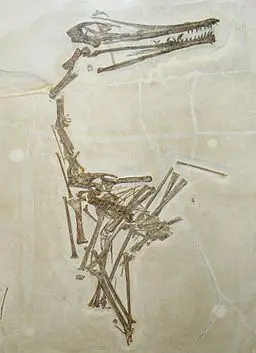
Ghedoghedo, CC BY-SA 3.0 https://creativecommons.org/licenses/by-sa/3.0, via Wikimedia Commons
Name: Ardeadactylus
Lived: Late Jurassic
Wingspan: 5 feet
Discovered: 1854
Where: Germany
Diet: Piscivore
Ardeadactylus
Name meaning: Heron Finger
Ardeadactylus is a genus of pterosaur from the Late Jurassic period. Its fossils were found in the Solnhofen Limestone in Germany.
The name “Ardeadactylus” is a combination of “ardea,” Latin for heron, and “dactylus,” Greek for finger.
The wingspan of Ardeadactylus is estimated to be around 1.5 meters (around 5 feet).
Based on its physical characteristics, it’s likely that Ardeadactylus fed on fish
More Information
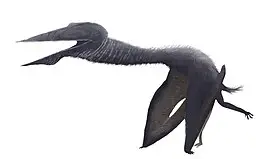
PaleoEquii, CC BY-SA 4.0 https://creativecommons.org/licenses/by-sa/4.0, via Wikimedia Commons
Name: Argentinadraco
Lived: Late Cretaceous
Wingspan: 7-10 feet
Discovered: 2011/2017
Where: Argentina
Diet: crustations
Argentinadraco
Name meaning: Argentina dragon
Argentinadraco is a genus of pterosaur that lived during the Late Cretaceous period. As the name suggests, its fossils were discovered in Argentina. “Argentinadraco” means “Argentina’s dragon”.
The exact size of Argentinadraco is uncertain, but estimates hover between 2-3 metres (7-10 feet) for the wingspan.
Belonging to the Azhdarchidae family, Argentinadraco likely had a long neck and toothless jaws, suggesting a diet of small animals and possibly carrion.
More Information
http://www.prehistoric-wildlife.com/species/a/argentinadraco.html
Name: Arthurdactylus
Lived: Early Cretaceous
Wingspan: 14-16 feet
Discovered: 1994
Where: Brazil
Diet: Piscivore
Arthurdactylus
Name meaning: Arthurs Finger
Arthurdactylus is a pterosaur from the Early Cretaceous period. Its fossils were found in the Santana Formation of Brazil.
The name “Arthurdactylus” honors Arthur Conan Doyle for ‘the Lost World’ ( the book not the Jurassic park movie!)
Arthurdactylus was a medium sized pterosaur and they had wingspans of around 4-5 meters (about 14-16 feet).
Arthurdactylus was a member of the Ornithocheiridae family, which is generally characterized by plenty of sharp teeth, suggesting a diet of fish.
More Information
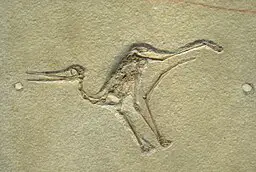
Daderot, Public domain, via Wikimedia Commons
Name: Aurorazhdarcho
Lived: Late Jurassic
Wingspan: 3 feet
Discovered: 1757 – 1779!
Where: Germany
Diet: Crustations?
Aurorazhdarcho
Name meaning: Dawn Pterosaur
Aurorazhdarcho was a pterosaur that lived during the Late Jurassic period. Its fossils were found in Germany. it may be the first ever Pterosaur fossil discovered!
The name “Aurorazhdarcho” combines “Aurora,” a reference to the dawn, and “azhdarcho,” a term often used for pterosaurs.
Aurorazhdarcho was a small pterosaur, with a crest on its beak / mouth. its wing span is thought to be around 3 feet.
More Information

Adele H. Pentland, Stephen F. Poropat, Travis R. Tischler, Trish Sloan, Robert A. Elliott, Harry A. Elliott, Judy A. Elliott and David A. Elliott, CC BY-SA 4.0 https://creativecommons.org/licenses/by-sa/4.0, via Wikimedia Commons
Name: Aussiedraco
Lived: Early Cretaceous
Wingspan: 10 feet
Discovered: 1980
Where: Australia
Diet: piscivore
Aussiedraco
Name meaning: Australian dragon
Aussiedraco is a pterosaur that lived during the Early Cretaceous period. Its fossils were discovered in Australia, (no prizes for guessing that! – hence the name “Aussiedraco,” which translates to “Australian dragon”.
The precise size of Aussiedraco is not known due to limited fossil evidence, but wingspan estimates start at around 3 to 3.5 metres (10 feet or so)
As a member of the Ornithocheiridae family, Aussiedraco were built for catching fish, which probably made up the bulk of its diet.
More Information
https://www.scielo.br/j/aabc/a/cbd3DSy74yzYnnrTvfqw73M/?format=pdf&lang=en
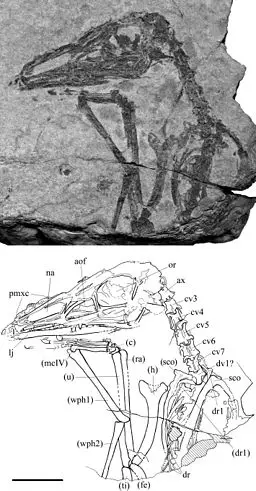
F.M. Dalla Vecchia, CC BY-SA 3.0 https://creativecommons.org/licenses/by-sa/3.0, via Wikimedia Commons
Name: Austriadactylus
Lived: Late Triassic
Wingspan: 4 feet
Discovered: 2002
Where: Austria
Diet: carnivore
Austriadactylus
Name meaning: Austria finger
Austriadactylus is a pterosaur from the Late Triassic period. It was discovered in Austria, as its name indicates. “Austriadactylus” means “Austrian finger”.
This pterosaur is one of the earliest known and was quite small, with a wingspan of only about 1.2 meters (almost 4 feet). It may have had 74 teeth though!
As one of the earliest pterosaurs, Austriadactylus had many primitive features, such as a long tail and a mouth full of sharp teeth, suggesting it might have eaten insects and small animals.
More Information
Name: Austriadraco
Lived: Late Triassic
Wingspan: 2.5 feet
Discovered: 1994
Where: Austria
Diet: carnivore
Austriadraco
Name meaning: Austria dragon
Austriadraco is a pterosaur that lived during the Late Triassic period, making it a very early example of a flying dinosaur. Its fossils were discovered in Austria, which is reflected in its name.
Austriadraco is thought to have had a wing span of under a metre – around 2.5 feet.
its pointy teeth, indicate a diet of fish and small invertebrates and anything else that scurried Infront of it!
More Information
https://pterosaurheresies.wordpress.com/2021/07/02/austriadraco-in-detail-at-last/
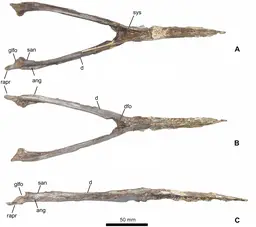
Rodrigo Vargas Pêgas, Maria Eduarda de Castro Leal, Alexander Wilhelm Armin Kellner, CC BY 2.5 https://creativecommons.org/licenses/by/2.5, via Wikimedia Commons
Name: Aymberedactylus
Lived: Early Cretaceous
Wingspan: 6.5 feet
Discovered: 2016
Where: Brazil
Diet: maybe Fruit
Aymberedactylus
Name meaning: Small Lizard Finger
Aymberedactylus is a pterosaur from the Early Cretaceous period. It was discovered in Brazil’s Crato Formation.
The name “Aymberedactylus” combines the Tupi words “aymberê” (lizard) and “dactylus” (finger).
Aymberedactylus Would have had a wingspan of up to 2 metres (6-7 feet) although it may not have been fully grown when it died/.
Aymberedactylus belonged to the Tapejaridae family, pterosaurs known for their crests and toothless beaks and weak bites suggesting a diet of fruit
More Information

PaleoEquii, CC BY-SA 4.0 https://creativecommons.org/licenses/by-sa/4.0, via Wikimedia Commons
Name: Azhdarcho
Lived: Late Cretaceous
Wingspan: 16 feet
Discovered: 1974-1981
Where: Uzbekistan
Diet: carnivore
Azhdarcho
Name meaning: Dragon Spear
Azhdarcho is a genus of pterosaur that lived during the Late Cretaceous period. Its fossils were found in Kazakhstan, and the name “Azhdarcho” comes from the Uzbek word for dragon.
Azhdarcho is one of the better-known members of the Azhdarchidae family which is big both in number and size
Azhdarvho is thought it have had a wingspan of approximately 5-6 meters (16-20 feet). It had a long neck and a toothless beak, suggesting a diet of small animals and dinosaurs and possibly carrion.
The Azhdarcho family is notable for its large size and presence in diverse environments, indicating adaptability and successful survival during its time.
More Information
https://www.zin.ru/journals/trudyzin/doc/vol_314_3/TZ_314_3_Averyanov.pdf
Click to Jump to the Flying Dinosaur Page Of your Choice!
A B C D E F G H I J K L M N O P Q R S T U V W X Y Z
Conclusion
So there you have the 30 or so Flying Dinosaurs or Pterosaurs that begin with the letter A, you can check out the links on the letters above to look at the other 200 or so Flying dinosaurs / pterosaurs that have been discovered so far!
Although these Flying dinosaurs were not in fact dinosaurs there were certainly prehistoric and definitely awesome! So a worthy addition to our site we think!
Hi, I am Roy Ford a General Studies and English Teacher who has taught all over the world. What started as a fossil collection became a great way to teach, motivate and inspire students of all ages and all over the world about dinosaurs and from that and children’s love of dinosaurs came the site dinosaur facts for kids, a resource for all ages.

